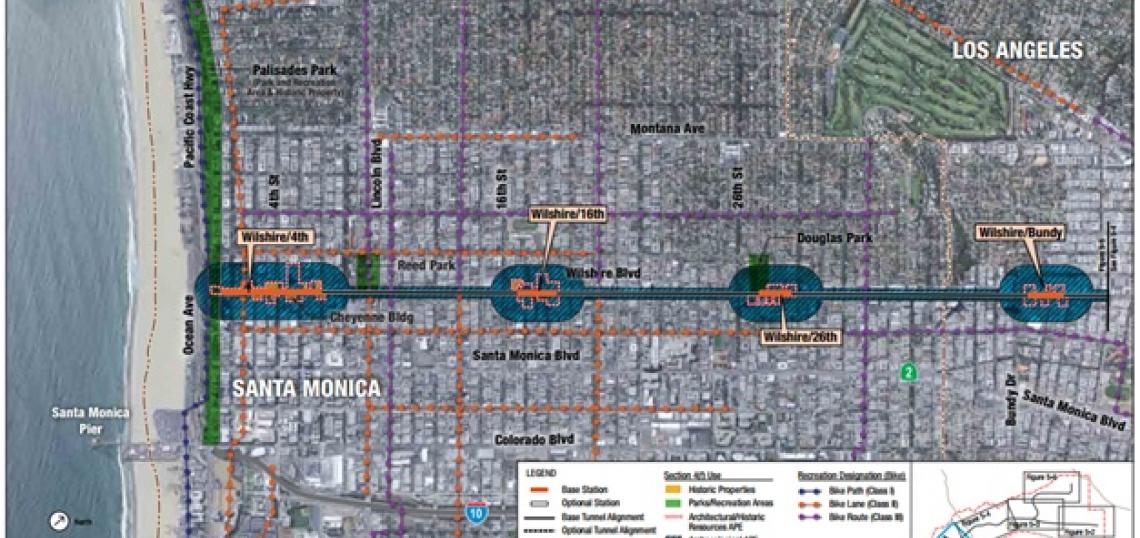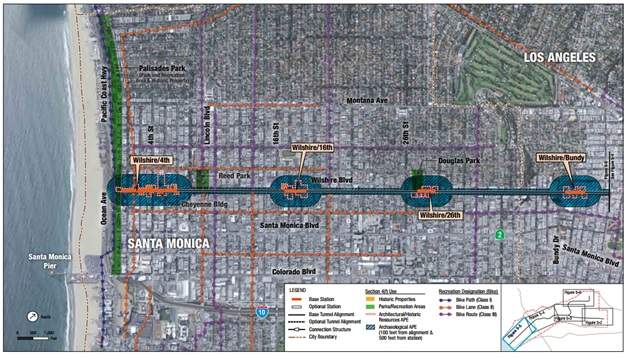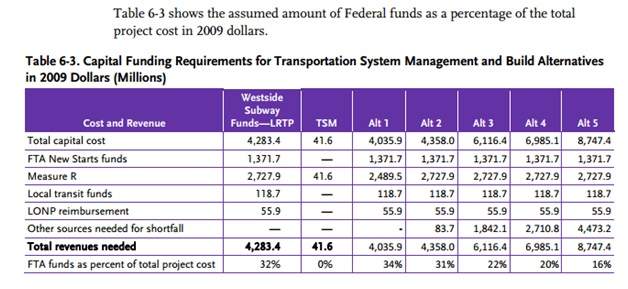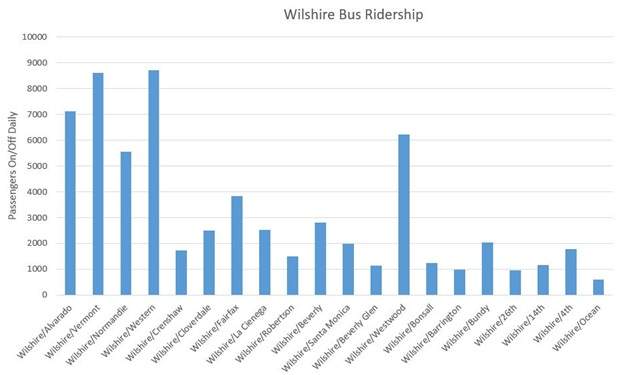Ever since the Wilshire subway was revived in the mid-2000s, there has been a question as to whether the Subway to the Sea needed to actually reach the sea. The Expo Line, after all, also takes riders to the Santa Monica shoreline, and its route within the beachside city parallels Wilshire at a distance of about a half-mile. To some, that makes the final grade-separated segment of the Purple Line a luxury, not a necessity. This debate featured in the planning process for Measure M as well. The Santa Monica extension of the Purple Line appeared on the initial wishlist for the Westside Cities COG and in several versions of MoveLA’s “strawman” expenditure plans. Ultimately, though, Metro’s directors decided to accelerate the project’s Westwood segment without providing additional funding to push further west.
In spite of its omission from the latest round of transit funding, it remains a good time to consider the Purple Line’s Santa Monica extension. As we were reminded a few weeks ago when the FTA issued their Full Funding Grant Agreement for the Purple Line’s second phase, the subway has been extremely successful in attracting federal funding. Metro has now secured nearly $3.8 billion in federal funds for the first two phases of construction, including $2.4 billion in grants.
Additionally, Metro will be drafting a new iteration of its Long Range Transportation Plan throughout the course of this year, and any projects that the agency wants to receive federal dollars will need to be on that document first. Eventually a source of local funding would need to be identified, but the LRTP is an important step in getting the project built in the next one to two decades.
The Santa Monica extension, which was included in the Purple Line’s environmental studies until the Westwood/VA alternative was chosen in 2010, consists of 4 stops over approximately 3.5 miles. From the Phase 3 terminus at Wilshire/Bonsall, the line would continue to a station at Bundy in Brentwood, making two stops in mid-city Santa Monica before ending up at 4th Street in downtown Santa Monica.
Much like the West Hollywood “Pink Line” (Alternatives 4 & 5, below), Metro wasn’t disinclined to build the Santa Monica extension of the Purple Line. It simply didn’t have the money on hand. The Draft EIR identified a shortfall of approximately $1.8 billion. In a bittersweet twist, Metro’s better-than-expected performance at corralling D.C.’s check-writers means that the agency has already made about half of the shortfall that planners projected in 2010, with the project’s most cost-effective segment still to come. And, unlike the Pink Line, which scored worse on the FTA’s cost-effectiveness matrix, Alternative 3, out to Wilshire/4th, had a score roughly on par with Alternative 1 (Wilshire/Westwood terminus), and only slightly below the VA Hospital alternative that was selected. Even though Metro estimated a marginal increase of only 9,000 riders between the VA Hospital and the beach, we might therefore expect that local governments would not be expected to foot the bill on their own.
The extension scores well on the cost per user benefit scale both because of the intensity of traffic delays west of the 405 and also because estimates have pegged this last segment as significantly cheaper than other parts of the route. The Purple Line is budgeted at about $800 million per mile overall, but MoveLA, during their prep work for Measure M, anticipated costs of around $625 million per mile between the VA Hospital and downtown Santa Monica. Perhaps this is in part because the first three phases pass through some of the most high-intensity land use in Los Angeles county, while the Santa Monica extension would primarily pass through low-rise residential neighborhoods.
That also forms one of the central knocks against moving forward with this project. It has been argued that the Purple Line should be withheld until Santa Monica, with its entrenched slow-growth and no-growth movements, agrees to upzone its portion of Wilshire. After all, even if it never makes it to the beach, the subway will connect the two job clusters – in Downtown and the Westwood/Century City – around which so much local transit ridership revolves. To be sure, the bus boardings are lower for this segment than elsewhere on Wilshire.
The above graph shows the relative strength of Wilshire’s on-off points, and it becomes clear that there are a few main points that attract most of the riders. Four of the top six stops are transfer points to the Metro rail system situated in the dense Koreatown and Westlake districts. The other two are Wilshire/Westwood and Fairfax’s Museum Row. But, otherwise, origin and destination points are weak. We can almost see the famous crowding of the Wilshire buses, as passengers get on gradually and ride for miles before all getting off together.
There are reasons to be optimistic about the potential for west-of-Westwood ridership to surprise on the upside of the initial estimate. In this part of town, traffic is incredibly slow-moving, even by L.A. standards. Google suggests a typical travel time between downtown Santa Monica and the VA hospital is about 25-35 minutes by bus. Metro also operates in direct competition with the Big Blue Bus, which provides service centered around UCLA and offers subsidized passes to students. We would expect the Purple Line, with its higher operating speeds, to be an attractive option for that demographic. It would also likely draw current 4 and 704 riders in Santa Monica by offering an easy one-seat ride to Century City, which the Wilshire buses do not.
Beyond that, the question appears to be whether the Purple Line does anything that Expo can’t do, and whether Los Angeles can support two lines connecting downtown Los Angeles and the beach. I would argue that the answer is yes to both questions. The east-west travel demand in this part of town is enormous and diverse. Though the end points are similar, each line serves areas separated by several miles and likely to develop distinct ridership bases.
To me, the more relevant issue is that the Expo Line may actually be ill-equipped to handle expected traffic if the final Purple Line segment is not completed. By the early 2030s, the Sepulveda Line will likely be open between the Expo and Orange Lines. When that happens, the Expo/Sepulveda station will turn into a pressure point with the potential to regularly overwhlem Expo’s capacity. Expo will be running at 5-minute headways on peak, and probably won’t be capable of more frequent service than that barring some key grade separation work, or a separation from the Blue Line. The Sepulveda Line will probably not share track and can thus run twice as frequently, while the Purple Line will run 6-car consists every 4 minutes during peak hours.
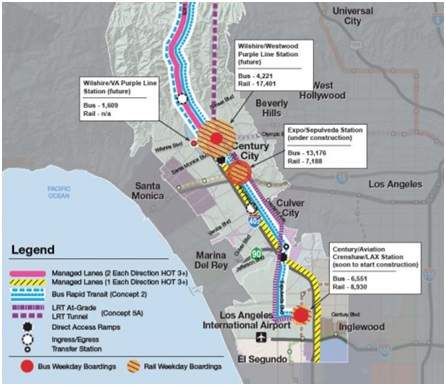
Using some capacity figures from Let’s Go LA and substituting for the relevant headways, we might expect westbound Expo to have a capacity of about 6,000 passengers/peak hour, as compared with about 16,000 passengers/peak hour for the westbound Purple Line and about 12,000 passengers/peak hour for the southbound Sepulveda Line. For both higher capacity lines, travel to Santa Monica would require transferring to the lower capacity Expo Line at Sepulveda. While most passengers would not be going to Santa Monica, a relatively small proportion of the numbers expected at Wilshire/Westwood could cause problems for Expo/Sepulveda. The problem would then compound when the Sepulveda Line was extended south to LAX, introducing a new set of riders transferring to Santa Monica at the same point.
It feels to me like the Subway to the Sea is a good idea that needs to be carried forward. With planning documents already in hand, it could reasonably be expected to begin construction around the time that the current extensions are slated to open in 2024, if a source of local matching funds could be secured. Perhaps the city of Los Angeles could use some of its local return dollars to help fund the portion of the project within its borders. In the meantime, Metro officials should make sure this project doesn’t fall off their radar. With the list of projects that county voters have agreed to fund, the Santa Monica extension of the Purple Line is now more essential than ever.
Scott Frazier is a graduate student at Cal State University Los Angeles in Public Administration. Follow him on Twitter @safrazie.




